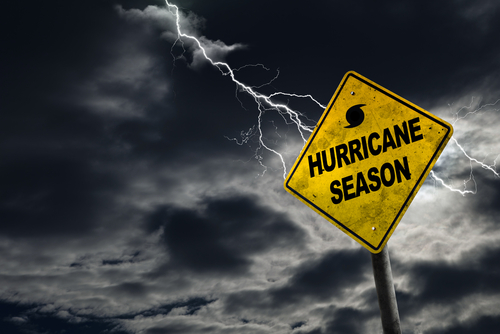As the Atlantic hurricane season looms, businesses must take proactive measures to protect their facilities from the potentially devastating impact of severe storms. With experts from the National Oceanic and Atmospheric Administration predicting a range of 12 to 17 named storms in 2023—with five to nine of them being hurricanes, including one to four Category 3 or higher storms—safeguarding the physical infrastructure of your organization is paramount.

Shockingly, up to 40% of affected businesses never reopen after a disaster strikes. But by prioritizing facility resilience and implementing effective hurricane preparedness strategies, businesses can minimize damage, ensure continuity of operations, and accelerate recovery. Below are five valuable tips and insights to enhance facility preparedness.
Step 1: Conduct Comprehensive Risk Assessments
The first step towards enhancing a business’s preparedness for hurricane season is assessing all potential risks and vulnerabilities of the facility to hurricane-related hazards. Do this by evaluating the structural integrity of the building, including the roof, windows, doors, and exterior walls.
Pro tip: make sure to video record the building’s interior and exterior before and after storms to assist in insurance claims.
Then, identify potential weak points and areas susceptible to wind and water damage. Pay special attention to rooftop equipment such as air conditioners and venting pipes to confirm they are adequately secured. It may be wise to work with professional engineers or consultants with expertise in structural analysis and hurricane resilience to help guide your assessment.
Once the assessment is complete, reinforce these vulnerable areas of the facility to withstand high winds and potential flooding. For example, install impact-resistant windows and doors, reinforce roofing systems, and secure loose items that could become projectiles during a hurricane.
Step 2: Educate Employees and Secure Essential Supplies
Along with the facility itself, the safety of employees should always be of top concern for businesses. That’s why the next step is to educate your employees by establishing formalized procedures to communicate with and protect workers during response and restoration periods. It is advisable to stock up on essential items like personal protective equipment (PPE), disinfectants, water, food, batteries, portable radios, first aid kits, and medications well in advance.
In addition to the essential personal items, it is also important to determine the emergency repair equipment required to sustain your business during and after a hurricane. Stockpiling supplies, such as chainsaws, pumps, fuel for generators, and plywood can prove invaluable. Make sure to conduct comprehensive training sessions to ensure all employees are familiar with this equipment, enabling them to act swiftly and appropriately during a hurricane.
Maintaining a supply of essential items to sustain employees during and after the storm will ultimately help to protect your facilities as well.
Step 3: Protect Critical Systems and Data
Maintaining accurate and up-to-date records is crucial for business continuity during and after a storm. Do this by gathering contact information for external parties, such as bankers, lawyers, accountants, and suppliers. Ensure contracts with customers and suppliers are up to date, and include appropriate provisions for risk transfer and proof of insurance. Additionally, having an up-to-date inventory of office and facility assets, including products and financial records, is equally as crucial.
Keeping physical records backed up in a secure location off-site or in the cloud safeguards against potential destruction.
Step 4: Develop a Robust Emergency Response Plan
Next, create a detailed emergency response plan that outlines protocols for evacuation, communication, and employee safety during a hurricane. Designate and train an emergency response team (or simply one individual and an alternate, depending on the size of your company) responsible for implementing the plan. Make sure that all employees are familiar with evacuation routes, shelter-in-place procedures, and emergency contact information.
The emergency response team should also be responsible for establishing connections with local Weather Service and emergency management offices for accurate information; that way they can receive early warnings and take appropriate measures to ensure the safety and security of your personnel, customers, and physical infrastructure.
Step 5: Review Insurance Coverage
After a storm, businesses often feel overwhelmed and uncertain about the next steps, particularly regarding accidents or losses. To ensure a smooth claims process during these challenging times, it is crucial to regularly initiate a thorough review of your property insurance with your agent or broker to ensure you have adequate coverage for hazards, floods, and business interruption.
Due to the current period of high inflation, it is especially important to ensure that property valuations reflect the cost of repairing, rebuilding, and replacing damaged property.
Prioritize Hurricane Preparedness
Protecting your business facility from the destructive forces of hurricanes requires proactive planning, resource allocation, and strategic decision-making. By conducting a comprehensive risk assessment, securing essential supplies and equipment, protecting critical systems and data, developing a robust emergency response plan, and reviewing insurance coverage, businesses can enhance their facility resilience.
Prioritizing hurricane preparedness not only ensures the safety of employees, but also helps businesses maintain operations and recover swiftly in the face of adversity. By fortifying their facilities, organizations demonstrate their commitment to resilience and safeguard their long-term success.

Ted Cabaniss is lead risk control consultant at insurance company QBE North America. He is a seasoned risk management professional with over 33 years of industry experience.
